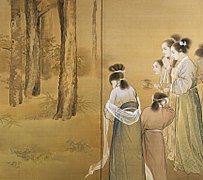Kikuchi Keigetsu
Kikuchi Keigetsu ( Japanese 菊池 契 月 ; born November 14, 1879 in Nakano ( Nagano Prefecture ); died September 9, 1955 ) was a Japanese painter of the Nihonga direction during the Meiji , Taishō and early Shōwa periods . He was, together with Nishiyama Suishō , one of the central figures of the Kyōto art scene.
life and work
Kikuchi Keigetsu, born as Hosono Kanji (細 野 完 爾), first studied painting in his homeland under Kodama Katei (児 玉 果 亭: 1841–1913), but then went to Kyoto in 1896 and formed himself there under the Nanga painter Utsumi Kodō (内海 古 堂) continue. He then attended the school of the painter Kikuchi Hōbun (菊池 芳 文; 1862-1918), whom he admired very much. He recognized his talent and took him on as a son-in-law.
Even before the first colorful exhibition, Kikuchi exhibited at the “Zenkoku kaiga kyōshinkai” (全国 絵 画 共進 会), the “Shin-kobijutsuhin-ten” (新 古 美術品 展) and on other occasions. Then followed pictures on the Bunter, and in the Taishō period he was occasionally appointed as a juror.
From the Taishō period onwards, Kikuchi painted on very precise preliminary drawings rather soft, showing feeling and decorative. In 1922 he was sent to Europe from the city of Kyoto. In Paris, he was impressed by ancient Egyptian sculptures radiating eternity in the Louvre . The late Gothic images in Italy with their statements of faith also moved him. Back in Japan in 1923 in Nara , he dealt with the Buddhist images of the Nara period . He also dealt with the Yamato-e and Ukiyo-e in order to create something modern on the basis of Japanese classical music. He mainly created figurative representations.
From 1909 Kikuchi was a teacher in Kyōto at the Municipal School for Arts and Crafts (京都 市立 美術 工 芸 学校, Kyōto shiritsu bijutsu kōgei gakkō), then at the Municipal College of Painting (京都 市立 絵 画 専 門 学校, Kyōto shiritsu kaiga semmon gak) became director of both schools in 1932 and was active in these positions and elsewhere until 1936. He was appointed art expert at the Imperial Court (帝室 芸 妓 員, Teishitsu geiki-in) and was a member of the Academy of Arts .
In 1986 the Japanese Post issued two 60 yen stamps with motifs from the legend of the legendary island "Haihateruma" (南波 照 間).
Remarks
- ↑ Bunten ( 文 展 ) is the abbreviation for the exhibition of the Ministry of Culture "Monbushō bijutsu tenrankai" ( 文部省 美術展 覧 会 ) in the years 1917 to 1918.
photos
literature
- National Museum of Modern Art, Kyoto (ed.): Kikuchi Keigetsu. In: Kyōto no Nihonga 1910–1930 . National Museum of Modern Art, Kyoto, 1986. ISBN 4-87642-117-X .
- Laurance P. Roberts: Kikuchi Keigetsu . In: A Dictionary of Japanese Artists . Weatherhill, 1976. ISBN 0-8348-0113-2 .
Web links
| personal data | |
|---|---|
| SURNAME | Kikuchi, Keigetsu |
| ALTERNATIVE NAMES | 菊池 契 月 (Japanese); Hosono Kanji (real name); 細 野 完 爾 (real name, Japanese) |
| BRIEF DESCRIPTION | Japanese painter |
| DATE OF BIRTH | November 14, 1879 |
| PLACE OF BIRTH | Nakano ( Nagano Prefecture ) |
| DATE OF DEATH | September 9, 1955 |







